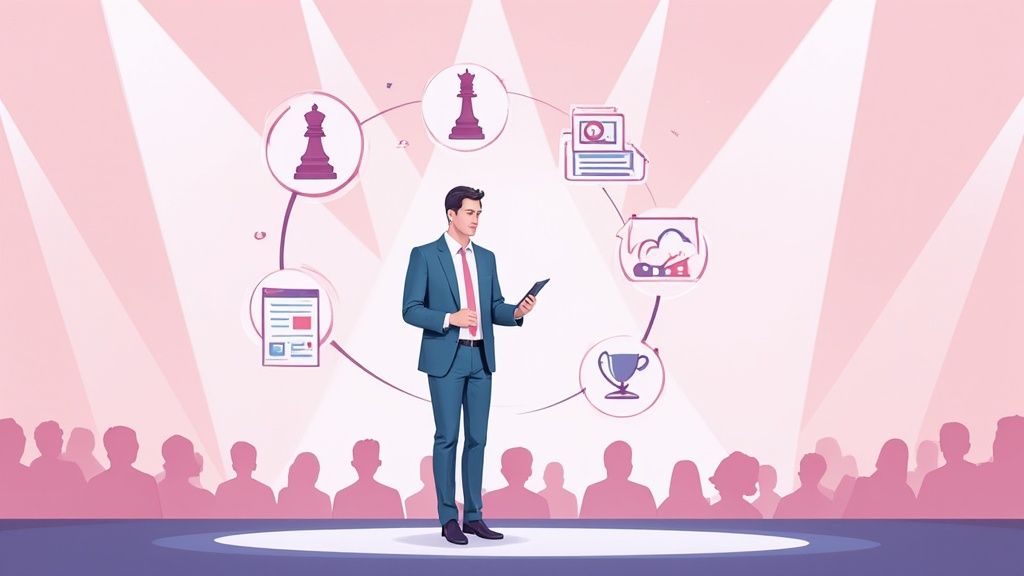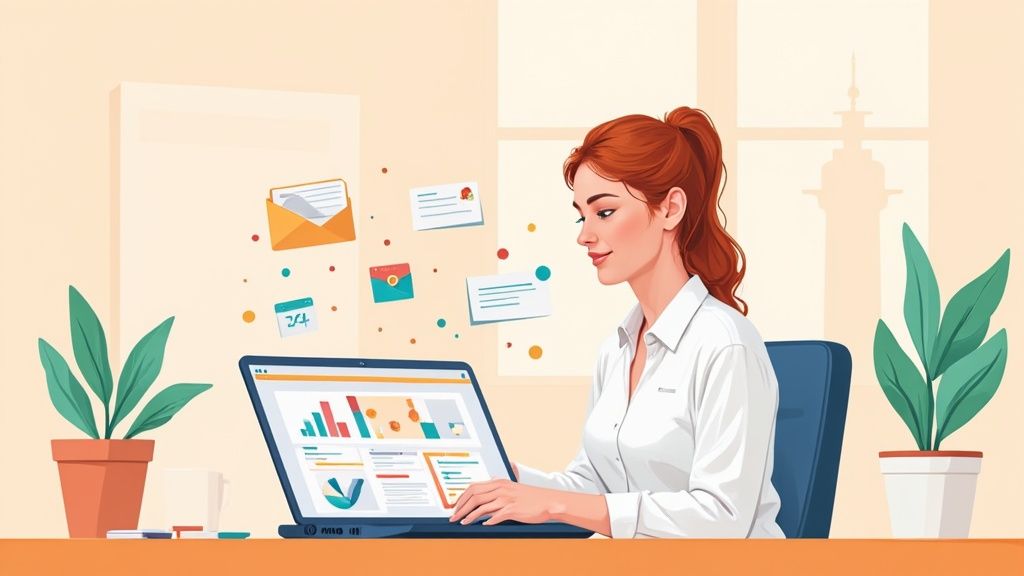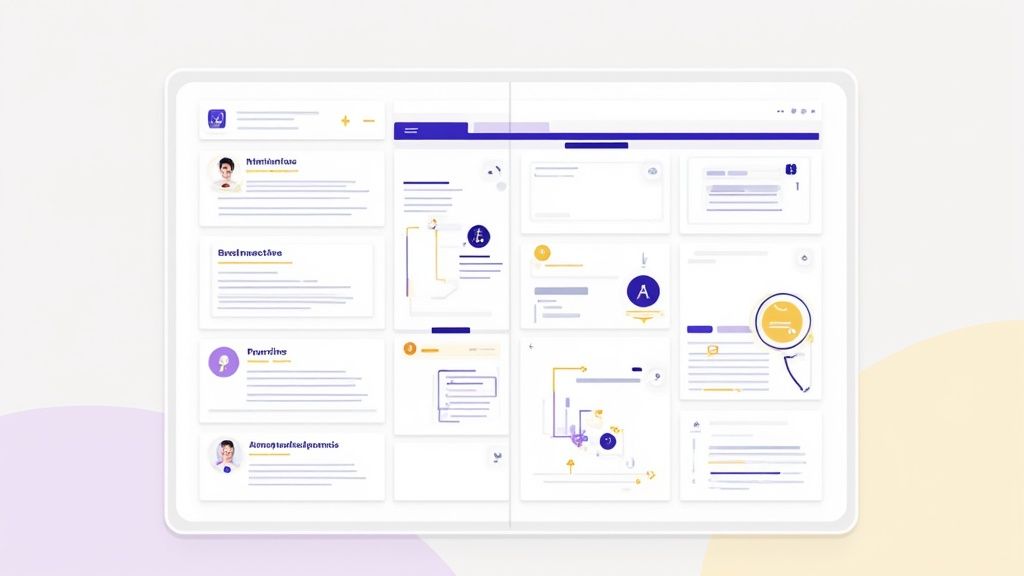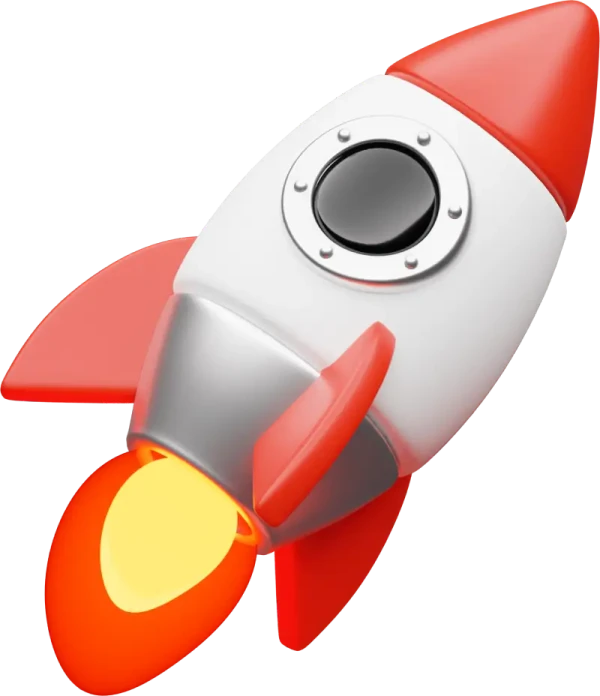Event content marketing isn't just a buzzword; it's a strategic way to create and share valuable stuff related to your event to pull in, hook, and ultimately win over your target audience. It’s how you turn a single, one-off event into a year-round engine for brand building, lead generation, and keeping your community engaged. This strategy is what makes your event investment pay off in real, measurable business results.
Why Event Content Marketing Is Your Secret Weapon
If you're only thinking about event marketing as a way to promote the event itself, you're leaving a massive opportunity on the table. A solid event content marketing plan does so much more than sell tickets. It builds a continuous loop of engagement that delivers value long before the doors open and well after they've closed.
It’s about building a genuine community, not just filling seats.
This approach transforms a one-time gathering into a powerful, ongoing story for your brand. By creating content that teaches, excites, and solves problems, you position your company as a thought leader and a resource people can actually trust. It's the difference between shouting at your audience and having a real conversation with them.
To get a clearer picture of how this works across the event lifecycle, here’s a quick breakdown of the core components.
Event Content Strategy At-a-Glance
| Event Phase | Primary Goal | Example Content Types |
|---|---|---|
| Pre-Event | Build hype, drive registrations, set the stage | Speaker Q&As, agenda sneak peeks, countdown posts, "why attend" blogs |
| During Event | Capture the experience, engage remote audiences | Live-tweeting, behind-the-scenes Stories, session quotes, attendee interviews |
| Post-Event | Extend the value, nurture leads, build a content library | Session recordings, keynote summaries, highlight reels, "top takeaways" infographics |
This table shows how each phase has a distinct purpose, with content tailored to match. It’s a roadmap for turning a single event into a multi-faceted campaign.
Amplify Your Reach Beyond The Venue Walls
An event is, by its nature, limited to a specific time and place. Your content, however, has no such boundaries. A smart content plan ensures your message reaches a global audience, including all the people who wanted to be there but couldn't make it. This digital extension of your event is absolutely crucial for maximizing its impact.
Just think about the benefits:
- Sky-High Brand Visibility: Sharing clips, powerful quotes, and key summaries on social media instantly exposes your event (and your brand) to entirely new audiences.
- Serious SEO Juice: Writing blog posts and detailed session summaries around your event's core themes can help you rank for valuable keywords, pulling in organic traffic for months, even years.
- Powerful Social Proof: User-generated content from your attendees - their photos, their takeaways, their "Aha!" moments - is an authentic testimonial that's far more persuasive than any polished ad you could run.
A powerful event content plan really comes to life when you have a well-defined social media content strategy to back it up. Every single piece of content, from a pre-event speaker spotlight to a post-event highlight reel, should work together to tell a cohesive story about your brand.
"Your event doesn't end when the last person leaves. It ends when you stop creating valuable content from it. The goal is to make the conversation, and the value, last all year."
Build A Lasting Content Library
Honestly, one of the biggest perks of a great event content plan is the treasure trove of assets you're left with. A single one-day conference can give you enough raw material to fuel your entire content calendar for a quarter, if not longer. This is where smart repurposing becomes your best friend.
Think about it. A single keynote speech can be sliced and diced into:
- A full-length video on YouTube for deep dives.
- An insightful blog post summarizing the key takeaways.
- A series of short, punchy video clips for TikTok and Instagram Reels.
- An audiogram for a podcast episode.
- Dozens of sleek quote graphics for LinkedIn and X (formerly Twitter).
This isn't about creating more work; it's about working smarter. This approach guarantees that every dollar and every hour you pour into your event pays you back over the long term.
There's a reason the global event industry is projected to hit $2.5 trillion by 2035. Organizers get it. In fact, 78% of event organizers say in-person conferences are their most impactful marketing channel, which just proves the incredible power of live interaction when you know how to leverage it.
Building Buzz Before the Doors Open
Let's be honest: the success of your event is often decided long before the first attendee walks through the door. The pre-event phase is where the magic really happens. This is your chance to build anticipation, lock in those registrations, and start creating a genuine sense of community.
Effective content marketing here isn't just about shouting your event's date and time from the rooftops. It’s about creating a palpable buzz, making your event feel like the place to be. Your goal is to show potential attendees the incredible value they'll get, give them exciting sneak peeks, and ultimately, make hitting that "register" button a no-brainer.
Crafting a High-Converting Event Hub
Think of your event landing page as the digital front door. It needs to do more than just list the facts; it has to sell the experience. A great landing page is clear, compelling, and built for one thing: conversion.
- Headline and Value Proposition: Start with a bold, punchy headline that immediately answers the question, "What's in it for me?" Are they coming to learn a game-changing skill, network with industry titans, or see groundbreaking tech? Make it crystal clear from the first glance.
- Essential Details Above the Fold: Don't make people hunt for the basics. Date, time, location (or virtual platform details), and a big, beautiful call-to-action (CTA) button should be right there, no scrolling required.
- Compelling Agenda and Speaker Previews: A simple list of session titles is boring. Instead, write short, benefit-driven descriptions. Show off your speakers with professional headshots and snappy bios that highlight exactly why someone should be excited to hear from them.
A classic mistake is burying the registration form. Put a simple, clean form right there on the page to make signing up as frictionless as possible. For a deeper look at optimizing this crucial step, exploring some event registration best practices can make a huge difference in not losing people at the finish line.
Sparking Excitement with Teaser Content
Once your landing page is live, it’s time to get people there and crank up the excitement. This is where teaser content comes in, giving your audience a reason to tune in and making them feel like they're part of an exclusive club.
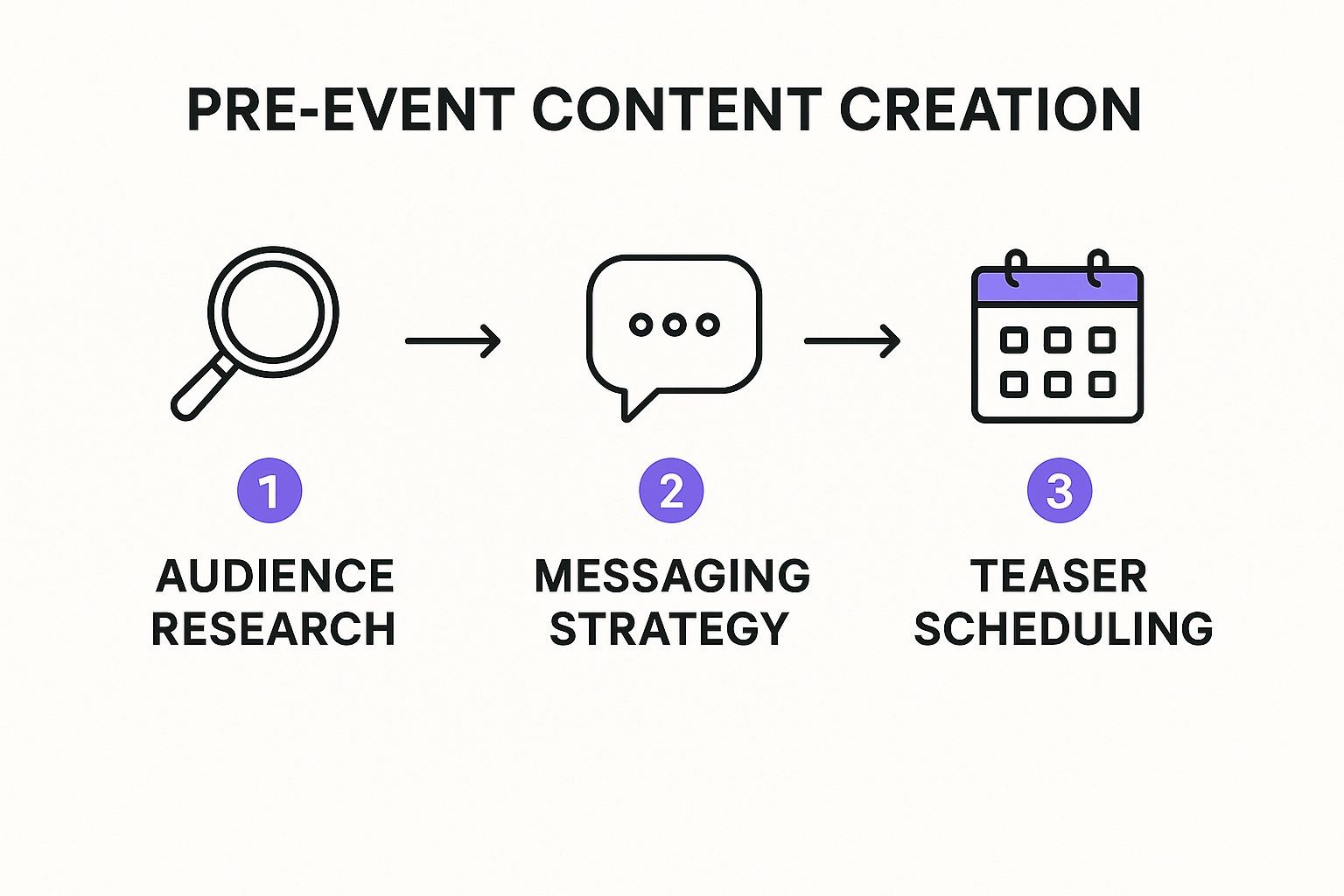
This process really boils down to knowing your audience inside and out. That understanding shapes your messaging and dictates how you roll out your teasers for the biggest impact.
The best pre-event content doesn't just announce; it invites people into the story of the event. Make them feel like they're on the journey with you from day one.
Try creating short video interviews with your keynote speakers. Ask them one provocative question about their topic and share their 30-second answer across your social channels. It’s a fantastic way to promote the speaker while giving a taste of the valuable insights attendees are in for. In fact, a whopping 89% of marketers report a positive ROI from using video for pre-event engagement.
Executing a Multi-Channel Nurture Strategy
Relying on a single channel is a recipe for being ignored. Your pre-event content needs to be a coordinated symphony across email, social media, and your blog to create a surround-sound effect that's impossible to miss.
Email Nurture Sequence Example
An email sequence is the perfect tool for guiding someone from casual interest to a confirmed registration.
- Email 1 (The Big Announcement): Kick things off by introducing the event, its core theme, and the main reason someone should attend. Drive them to the landing page.
- Email 2 (The Problem/Solution): Zero in on a major pain point your audience deals with. Then, show them exactly how a specific session or speaker will provide the solution.
- Email 3 (The Social Proof): Build credibility by sharing glowing testimonials from last year's event or highlighting some of the impressive companies that have already signed up.
- Email 4 (The Nudge): Create a little urgency. Announce an early-bird discount deadline or a special bonus for those who register now.
Social Media Campaign
On social media, it's all about visual, shareable content. Start a countdown series with daily posts highlighting a new speaker, a cool session, or a unique networking opportunity. Run a poll asking your followers what they're most excited to learn. You can even share behind-the-scenes photos of the venue being set up or your team in planning mode - it builds a real human connection.
By combining an optimized landing page with a smart mix of teaser content and multi-channel nurturing, you create an atmosphere of genuine anticipation. This approach doesn't just get you "likes" - it translates directly into a full house and a highly engaged audience before the event even starts.
Capturing Content in the Live Environment
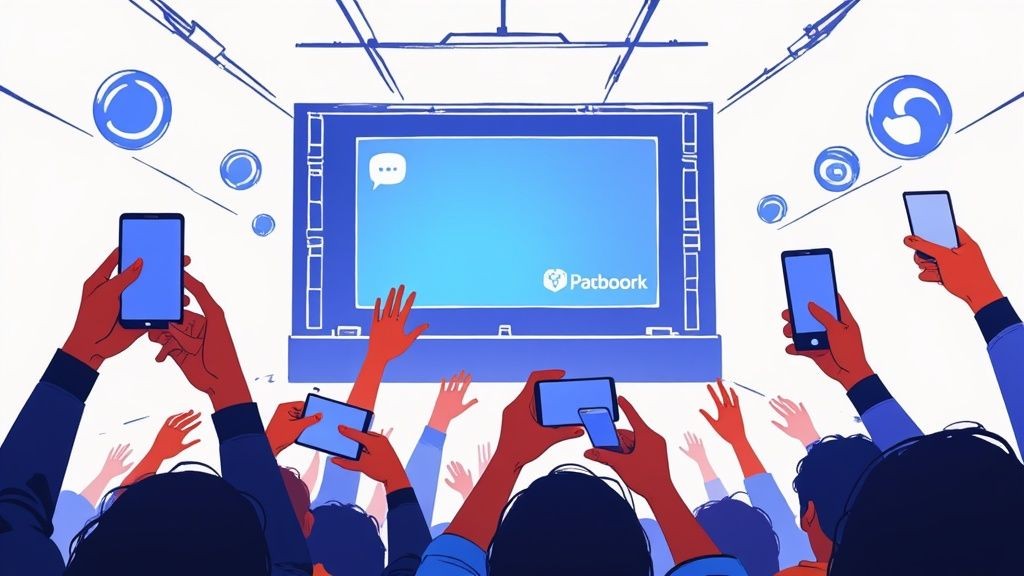
The day of the event is finally here. The energy is buzzing, but so is the potential for things to get chaotic. This is the moment where all that pre-event planning truly proves its worth.
Your goal is to bottle the magic of the moment - to capture high-quality content without getting completely overwhelmed. It's a tricky balance between being present and being a documentarian, but with the right plan, it's more than achievable.
Success during the live event hinges on having a clear plan, a designated team, and the right tools. We're not just talking about recording sessions; we're talking about capturing the authentic energy and interactions that make your event one-of-a-kind.
Assembling Your Content Capture Crew
You don't need a Hollywood-sized production crew to get stellar content. In fact, a lean, coordinated team where everyone knows their role is far more effective. Trying to do everything yourself is a surefire way to miss the best moments and burn out before the first coffee break.
Even a small team can make a huge impact:
- The Roving Photographer/Videographer: This person is your eyes on the ground, capturing the human element. Their focus should be on candid shots of attendees networking, laughing, and getting absorbed in sessions. They also grab the professional, polished shots of speakers and stage setups.
- The Social Media Correspondent: This is your real-time voice. They’re live-tweeting impactful quotes, posting behind-the-scenes Instagram Stories, and engaging with attendees using your event hashtag. They keep the online conversation alive.
- The Interviewer: This role is how you get those golden testimonials. They should have a hit list of key people to talk to - speakers, sponsors, super-engaged attendees - and be ready to pull them aside for a quick, two-minute video interview.
For smaller events, one person might wear two of these hats. That's perfectly fine, as long as the responsibilities are crystal clear. This simple act of defining roles prevents overlap and guarantees all your content bases are covered.
Identifying and Documenting Key Moments
With the clock ticking, you can't capture everything. You have to be strategic. Before the doors even open, your team needs a "shot list" of must-have content.
This list should be a healthy mix of planned shots and room for spontaneous magic.
Planned Content to Capture:
- Full recordings of all keynote sessions and the most popular breakouts.
- High-quality audio recordings you can later turn into podcast episodes.
- Scheduled 5-minute interviews with every speaker right after they step off stage, while their energy is still high.
Spontaneous Content to Watch For:
- Attendees having those "aha!" moments during a talk.
- The genuine buzz and chatter during networking breaks.
- People interacting with sponsor booths or other experiential activations.
The most powerful event content often comes from unscripted moments. Empower your team to spot and capture genuine emotion - an attendee's excited reaction, a speaker's passionate ad-lib, or a lively Q&A exchange. These are the assets that feel most authentic.
Encouraging User-Generated Content
Let's be honest, your best and most passionate marketers are already in the room: your attendees. The trick is to make it incredibly easy and fun for them to create and share content on your behalf.
This is where you can engineer a few "social media moments."
Consider setting up a designated, well-lit photo booth with a branded backdrop and fun props. Or, install a live social media wall that displays posts using your event hashtag in real-time. This not only encourages more posts but also builds a fantastic sense of shared experience.
A live Q&A wall where attendees submit questions via their phones is another great tool. You can screenshot the most insightful questions to share later, showcasing the high level of engagement from your audience.
By making it easy, you turn passive listeners into active participants and co-creators of your event's story. When the curtains close, you won’t just have your own content - you’ll have a treasure trove of authentic material from the people who mattered most.
Keeping The Momentum After The Event Ends
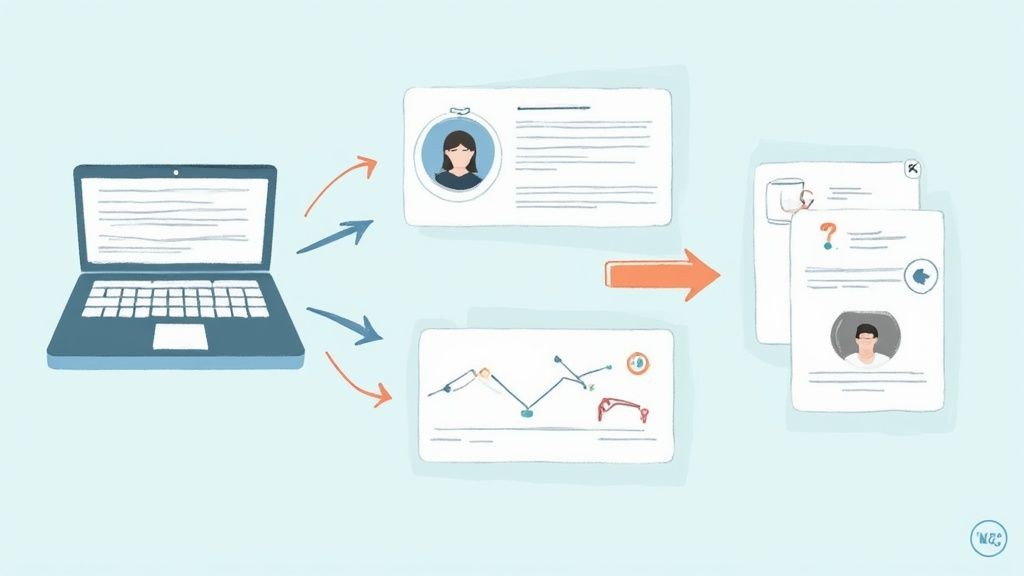
The closing remarks are done and the venue is empty, but your event is far from over. Honestly, the most important phase for unlocking its long-term ROI is just kicking off. The weeks and months that follow are your golden opportunity to transform the energy and insights from your live event into lasting assets that nurture leads and build your brand's authority.
This post-event period is where a smart content strategy really proves its worth. It’s your chance to keep the conversation going, deliver exclusive value to attendees, and even pull in the audience who couldn't make it. The goal is simple: make your event’s impact feel permanent, not like a fleeting moment.
This isn't just about grabbing new leads, either. Seventy-one percent of event professionals use events for both customer acquisition and retention. And that focus on retention pays off - companies that prioritize it are 13% more likely to see over 10% year-over-year growth. You can dive into the full findings from Swoogo.events right here.
Transforming Raw Footage Into Polished Assets
Think about all the content you captured during the event - session recordings, photos, candid testimonials. That’s your raw material. Now it’s time to start refining it into polished pieces that can fuel your marketing for months. This is all about strategic content repurposing.
It's like a chef breaking down a prime cut of meat. One big piece can be turned into a dozen different, equally delicious dishes. Your keynote recording isn’t just one video; it’s a goldmine of potential content waiting to be created.
To really stretch the lifespan and impact of your event content, it’s worth exploring effective content repurposing strategies. This is the secret to working smarter, not harder, with the valuable material you’ve already gathered.
The Post-Event Content Playbook
A solid plan ensures no opportunity slips through the cracks. Your distribution should be a multi-channel effort designed to keep the event top-of-mind and continue delivering value.
Here are some of the most powerful content formats to focus on:
- On-Demand Session Videos: Edit and upload your key session recordings. You can offer them up freely to build goodwill or gate them behind a simple form to generate new leads from people who missed out.
- Insightful Blog Posts: Write detailed summaries of the top sessions. Don't just post a transcript - pull out the most important takeaways, sprinkle in your own perspective, and embed relevant video clips or speaker quotes.
- Powerful Quote Graphics: Snag the most impactful one-liners from your speakers and turn them into eye-catching graphics for social media. These are super shareable and fantastic for reinforcing key messages.
- The Sizzle Reel: Stitch together a high-energy, 1-2 minute highlight video. This "sizzle reel" is the perfect marketing tool for next year's event, bottling up the excitement in a way words just can't match.
By systematically working through your raw content, you build a rich library that serves different purposes on different platforms, guaranteeing you reach the widest possible audience.
The real value of an event isn't just in the leads you generate on the day, but in the relationships you nurture afterward. Your post-event content is the bridge that keeps that conversation going, turning attendees into loyal advocates.
Nurturing Leads With Exclusive Content
Your list of attendees and registrants is pure gold. They’ve already shown a high level of interest, and now is the time to nurture that relationship with exclusive, high-value content sent straight to their inbox. This is where your email marketing becomes a powerhouse.
Your follow-up email sequence should feel less like a marketing blast and more like a concierge service, hand-delivering the best of the event. For more on crafting killer email campaigns, check out our detailed guide to email marketing for events.
An Example Post-Event Email Flow That Works:
- The "Thank You & Here's What You Missed" Email (Day 1-2): Send a thank you note to all attendees. Toss in a link to a "best of" blog post or the official photo gallery to reignite their excitement.
- The Session Recordings Email (Week 1): Announce that the session recordings are live. I like to highlight 2-3 of the most popular talks and then link to the full on-demand library.
- The Deep Dive Email (Week 2): Send a piece of content that goes deeper on a key theme from the event, like a comprehensive white paper or an exclusive interview with a keynote speaker.
- The "What's Next?" Email (Week 3-4): Keep the momentum going. Invite them to your next webinar, encourage them to subscribe to your newsletter, or give them a heads-up about next year's event dates.
This deliberate, value-first approach solidifies your brand as an authority and keeps your audience engaged. It makes them far more likely to come back for your next event and - even better - tell their friends about you.
How to Measure Your Content's True Impact
Let's be honest: creating incredible event content is only half the job. If you can't prove your marketing efforts actually moved the needle, you’ll have a tough time getting the budget approved for next year's event.
To show real value, you have to look beyond surface-level "vanity metrics" like likes and shares. Instead, you need to laser-focus on the key performance indicators (KPIs) that your leadership team actually cares about - the ones tied directly to business goals.
Measuring the real impact means connecting your content activities to cold, hard business outcomes. This involves tracking specific metrics before, during, and after your event to paint a clear picture of your return on investment (ROI).
Tracking Pre-Event Success
Before a single person walks through the door (or logs into the webinar), your main goals are driving awareness and getting sign-ups. The success of your content here is all about its power to turn interest into action.
Focus on these core metrics:
- Landing Page Conversion Rate: This is the big one. What percentage of people visiting your event page actually register? A low rate is a red flag, pointing to potential problems with your copy, design, or call-to-action.
- Registration Source Tracking: Where are your sign-ups coming from? Using UTM parameters in your links is non-negotiable. It tells you if registrations came from an email campaign, a specific social post, or that guest blog you wrote. This is how you know which channels are worth your time and money.
- Email Open and Click-Through Rates: Are people actually opening and clicking on your pre-event emails? High open rates mean your subject lines are hitting the mark. Strong click-through rates tell you the content inside is compelling enough to make them act.
Keeping a close eye on these numbers lets you tweak your strategy in real-time, doubling down on what works and pulling back on what doesn't.
Gauging Live Engagement
Once the event is underway, your focus shifts from conversion to engagement. You want to see how your content is amplifying the live experience for everyone, whether they're in the room or watching from home.
The most successful events create a feedback loop where live engagement fuels online conversation, and online conversation pulls more people into the live experience. Your metrics should reflect this dynamic interplay.
Here’s what to look for:
- Hashtag Mentions and Reach: How many people are using your official event hashtag? More importantly, what's the total potential audience of those posts? This metric shows you how far your event's message is spreading beyond the venue walls.
- User-Generated Content (UGC) Volume: Keep track of the photos, videos, and posts your attendees are sharing. A flood of UGC is powerful social proof and a clear sign that your audience is genuinely excited and engaged.
- Live Stream Viewership and Engagement: If you have a virtual or hybrid component, you need to know how many people are watching, for how long, and if they're interacting. This data is gold and can directly help you increase event attendance for future virtual sessions.
Attributing Post-Event ROI
This is where the rubber meets the road - connecting your event content directly to the bottom line. The most common KPIs for overall event success often come down to registrations (54%), leads and sales opportunities (53%), and actual attendance (40%). But let's be real, a lot of marketers struggle with accurate reporting.
To get a true sense of your content's effectiveness, you need to dig into the key content performance metrics that reveal what your audience actually did.
Here’s a simple framework for tying your efforts to revenue:
- Lead Generation from Gated Content: After the event, put your best content - like session recordings or exclusive reports - behind a simple form. Track every single lead that comes from it.
- Influenced Sales Pipeline: This requires teamwork. Partner with your sales department to tag every event-generated lead in your CRM. Then, over the next few months, watch how many of those leads turn into qualified opportunities or, even better, closed deals.
- Content Engagement by Prospects: Use your marketing automation platform to see which pieces of post-event content (like follow-up blogs or on-demand webinars) your existing prospects engaged with right before they made a purchase. This shows your content's role in nurturing them across the finish line.
By meticulously tracking these metrics, you can stop just saying "the event was a success" and start proving it with hard data. You'll be able to walk into any budget meeting and demonstrate the undeniable financial impact of your event content.
Of course. Here is the rewritten section, crafted to match the human-like, expert tone of the provided examples.
Your Event Content Marketing Questions, Answered
Let's be real. Even with a killer strategy mapped out, you’re going to hit some bumps in the road. When you're in the thick of planning, practical questions always pop up.
So, let's tackle a few of the most common ones I hear from event marketers. Think of this as your quick-reference guide for those "what do I do now?" moments.
How Early Is Too Early to Start Promoting?
This is probably the number one question I get. And for good reason - timing is everything.
You want to start early enough to build real momentum, but not so early that people forget about your event by the time it rolls around. The sweet spot? Aim to kick off your main content push 2-3 months before the event date.
This gives you plenty of runway to build awareness, nurture interest, and drive registrations without causing audience fatigue. Any earlier, and you risk your message getting lost. Any later, and you're just scrambling.
How Do I Create Content with Zero Budget?
Ah, the classic "no budget" dilemma. I've been there. The good news is, a lack of cash doesn't mean a lack of content. It just means you have to get scrappy and resourceful.
Forget about what you can't do and focus on what you can. You probably have more assets at your fingertips than you realize.
Here are a few no-cost ideas to get you started:
- Lean on Your Speakers: Your speakers are your built-in subject matter experts. Don't be afraid to ask them for a little help! A short guest post for your blog or a quick selfie video answering a key question about their session is gold. It costs you nothing and gives you instant, credible content.
- Embrace User-Generated Content (UGC): Your past attendees are your best advocates. Run a simple social media contest asking them to share their favorite photo or memory from a previous event. The prize can be as simple as a discount on this year's ticket. You get authentic social proof and drive ticket sales at the same time.
- Repurpose Absolutely Everything: Take your event agenda and slice it into a dozen different social media posts, each highlighting a specific session or track. Turn your FAQ page into an "Ask Me Anything" session on Instagram Stories. Get creative!
The whole game is about taking what you already have - your speakers, your community, your event details - and spinning it into fresh, engaging content.
What Content Formats Actually Work Best?
There's no magic bullet here. The "best" format changes depending on where your audience is in their journey. It’s less about finding one perfect format and more about using the right tool for the job at the right time.
The most effective content is all about context. It has to match your audience's mindset in that specific moment. Pre-event content needs to build hype, while post-event content should deliver lasting value.
To make it simple, here’s a quick guide to what usually works and when:
| Format | Main Objective | Best Channels |
|---|---|---|
| Short-Form Video | Generate hype and excitement | Instagram Reels, TikTok, YouTube Shorts |
| Blog Articles | Educate and build SEO authority | Your Website, LinkedIn, Email Newsletters |
| Testimonials/Case Studies | Provide social proof and build trust | Landing Page, Social Media, Emails |
| Downloadable Checklists | Offer practical, immediate value | Gated Landing Pages, Email Campaigns |
And the data doesn't lie. For example, a staggering 89% of marketers say video gives them a positive ROI for pre-event buzz.
Your best bet is a healthy mix. A varied approach keeps things interesting and ensures you’re meeting your audience on the platforms they actually use.
Managing and promoting events shouldn't feel like a constant struggle. Add to Calendar PRO makes it simple with easy-to-use "Add to Calendar" buttons, built-in RSVP management, and automatically generated, SEO-friendly landing pages. Discover how our platform can amplify your next event.
